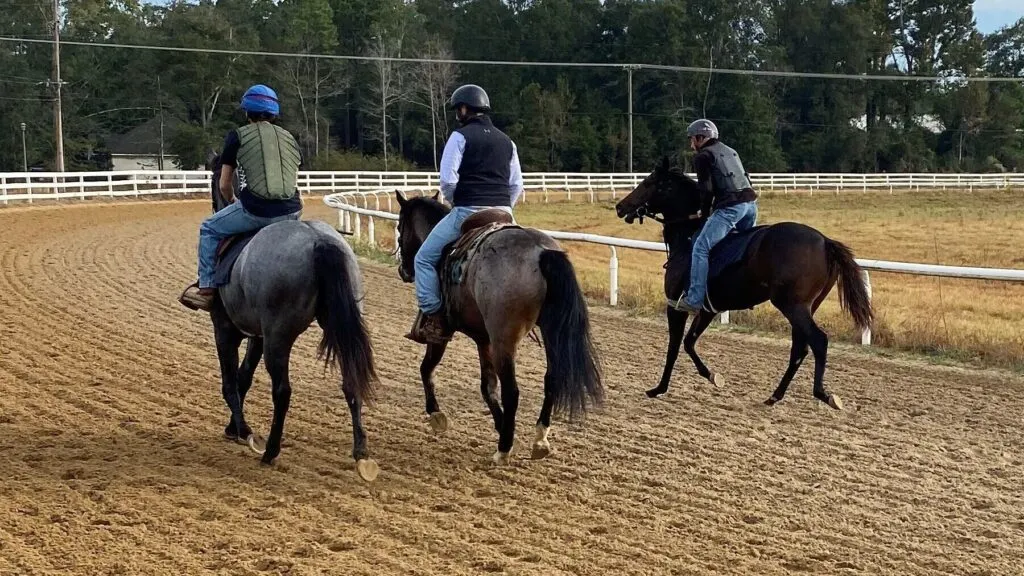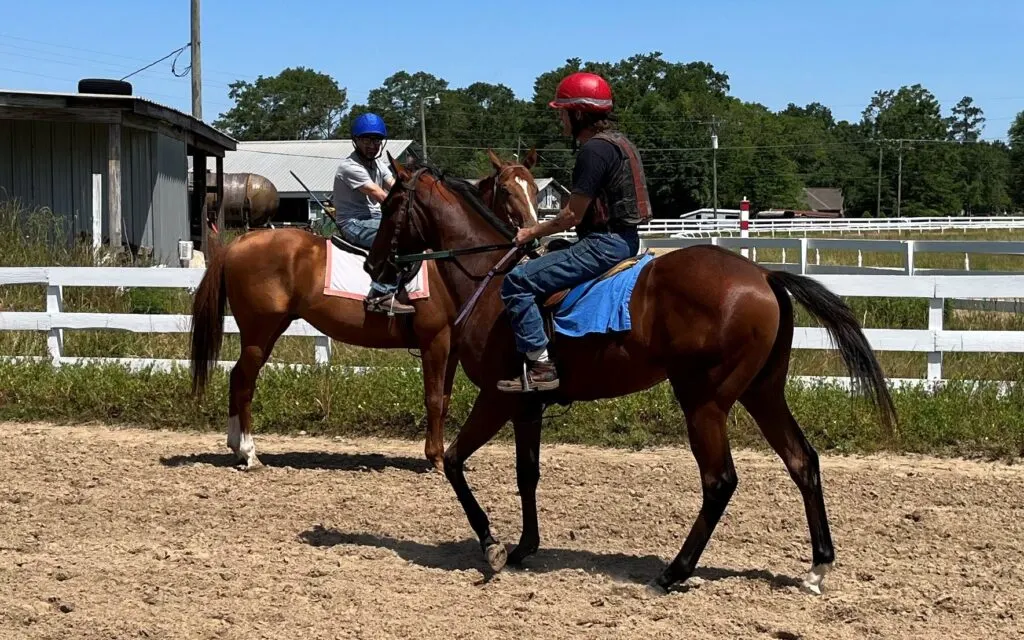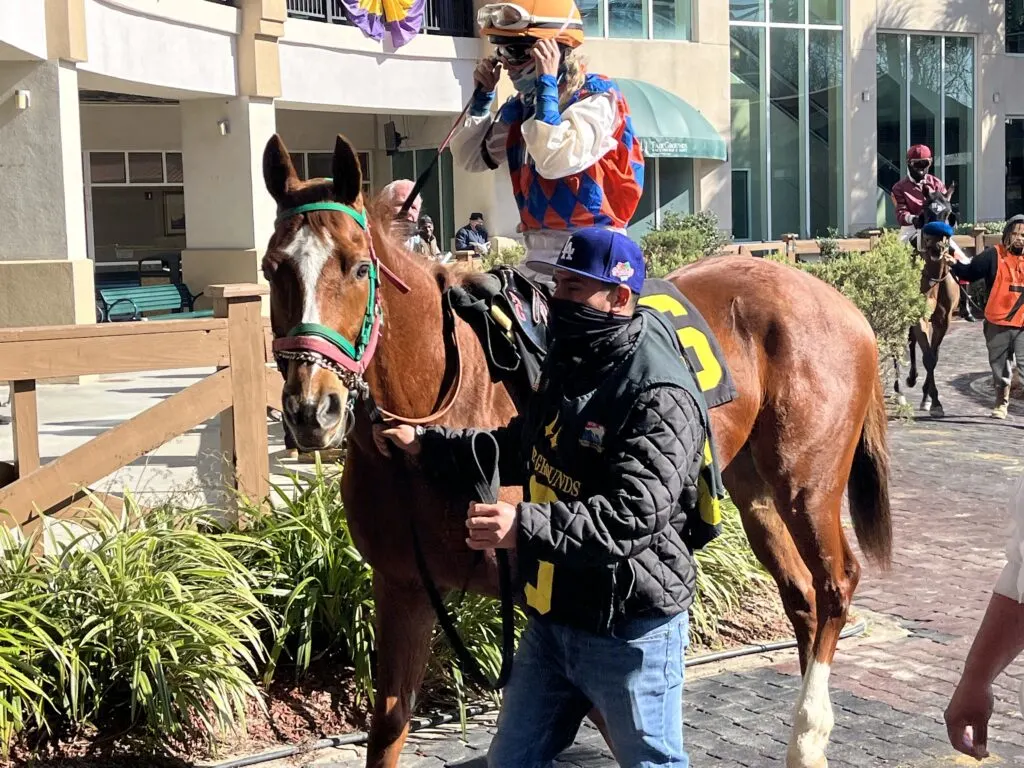Last updated: December 31, 2023
Did you know that the most crucial training sessions for racehorses occur when most of the world is still asleep? As the first light of day breaks, race tracks come alive with galloping of horses. This early morning ritual, a common sight at training centers, isn’t just a matter of tradition; it’s a well-thought-out strategy integral to the world of horse racing.
It is a blend of practical and horse-centric considerations. Early training sessions are timed to precede the afternoon races, allowing trainers and jockeys to prepare without the rush. Additionally, cooler temperatures at dawn offer a more comfortable environment for the horses, reducing the risk of heat stress. The early hours also help manage the flow of equine traffic at the facility and align with the availability of jockeys.
I’ve spent over 25 years in the horse racing industry, and in this article, I’ll shed light on why racehorses train during the early morning hours and explain why it’s not only a preference but a necessity in the training regimen.

Why early morning training is necessary for racehorses.
A lot of horses share a track.
We’ve used a few different tracks to train our racehorses, both public and private facilities. At open training tracks, you share the course with lots of other trainers.
Some training facilities are semi-public.
The largest training facility in our area is the Folsom Training Center. The earliest you can start is 5:30 am. On a typical day, there will be horses lined up and ready to go as soon as they are allowed to enter the track.
The YouTube video below describes our local training facility. It is set up like a condominium association. Each barn is privately owned and contributes to a maintenance fee for the track and common grounds.
In Louisiana, it’s essential to get your horses on the track early because of the heat. Heat exhaustion and dehydration are significant concerns. It warms up fast in south Louisiana, and the high temperatures aren’t suitable for working horses.
Training sessions for the horses include either walking, trotting, galloping, and working (running). A large number of horses that get on the track requires you to start early before the course gets overcrowded.
Horses get fed at least an hour before training.
On an average day, trainers get to the barns at least an hour before taking the horses to the track. When they first arrive, they make sure the horses are fed and ensure each horse is appropriately prepared for its workout.
Adequate preparation includes checking the horses’ feet and legs for any heat, grooming, wrapping the legs if necessary, and tacking the horse. The exercise jockeys make their rounds. They have to schedule their mounts.

Training jockeys ride many horses each morning.
One jockey may ride a horse for a trainer, then move to another barn to ride for a different trainer, then go back and ride for the first trainer a second and third time. He may ride upwards of twenty horses each morning.
Each horse in a trainer’s barn has its workout schedule depending on its level of fitness and distance; he is training to race. Some horses may go to the track for a morning jog to loosen up. Others may work at a race pace.
Every horse has an individual training schedule.
Once the horse has concluded his training on the track, he is taken back to the barn to have his tack and saddle removed. The groom checks the horse for any problems and rinses him before beginning a cool-down walk.
Some trainers like to hand-walk their horses, but most put the horses on a walker. While the horse is out of the barn, the stall is cleaned, and fresh hay is hung. After the cool-down period, the horse is given a good bath and returned to his stable.
It commonly takes a trainer until noon to finish his morning routine. If he has horses running later that evening, he will start preparing for the races now.
Private racehorse training facilities have less traffic.
Sometimes it is easier to use a private training facility. We have kept horses at our home and used a neighbor’s track to work our racehorse in the mornings. At private facilities, there is less horse traffic.
We didn’t need to get to the track early to ensure we had open lanes to work, but we still had to consider the temperature and the availability of a jockey, and on weekdays, I had to work.

Our procedure included waking up at four and feeding our horse, getting him ready to trailer over to the track, and meeting the jockey at 6 am. This process worked great for us, and I especially appreciated having an open course for our young horse.
Horses benefit from socializing on the track.
But horses need to be around other horses and in different environments to be successful racehorses. If their only exposure to the sights and sounds of a bustling racing facility is on race day, there is a risk of the horse washing out.
In horse lingo, “washing out” is when a horse becomes soaking wet from sweating because it’s nervous. When a horse “washes out,” it’s in danger of dehydrating and likely won’t load in the starting gates. You can learn more about horse sweating here.
Public racehorse training facilities have the most traffic.
Trainers have barns on the “backside” of racetracks. The “backside” of a track is a term used to describe the stables and living areas for staff located on the racetrack grounds. It is usually behind the track, opposite the grandstands.
Trainers who run a group of horses at a track will lease a barn during the race season. Trainers with one or two horses can rent a stall in a barn at the track. The New Orleans Fairgrounds has stall applications you can view here.
Some big-time trainers have barns at multiple racetracks. High-level trainers have associates manage the barns when he is not present. To read more about becoming a trainer and the duties of a trainer, click here.
There are advantages to keeping a racehorse at a racetrack. Being housed at the track gives the horse familiarity with the running surface and surroundings. The horse isn’t hauled in for the race and is familiar with the starting gates and the jockey.
The reason trainers train early at racetracks is because the track has a schedule for training hours each morning. There is a large number of horses housed at all tracks. Trainers have to start working horses early or risk, not having enough time to exercise all of their horses.

Do Jockeys Ride the Horse Before the Race?
A friend of mine was excited because he had secured a leading jockey to ride a horse for him in a stakes race. I know top jockeys stay really busy, so I wondered if he would have an opportunity to ride the horse before the race.
Jockeys typically ride a horse before its race if the horse trains at the racetrack of the competition. During workouts, the trainers encourage the race jockey to ride their mounts so the horse and rider become familiar with each other.
Racehorses kept at off-site training facilities are less likely to have been ridden by the race jockey before the race, but this is not always the case. Racehorses need official work before it’s eligible to run.
Official workouts are run in public and timed by track officials. The times from the workouts are published in racing forms used by gamblers. A horse is required to have a certain number of official works before it is eligible to race.
For an official workout, a trainer will encourage the race jockey to ride his horse. Horses kept at off-side training sites are hauled to the racetrack for official workouts.
I can guarantee that every jockey in the Kentucky Derby rode his mount before the big race.

What Age Do Racehorses Start Training?
When I go watch the horses train in the morning, there are always a lot of extremely young horses on the track. To already be working on the track, the horses must start training at an awfully young age.
Racehorse training starts at a very young age. Typically, racehorses are halter broken by the time they are a yearling. By the time they are two, they are saddlebroken and taken to the training track.
Horses are individuals and develop at different rates. A horse’s knees have to grow to a particular stage before heavy pressure created by running while carrying a person can be put on them. Quarter horses’ knees typically develop earlier than Thoroughbreds’ horses.
Conclusion: Why Racehorses Train Early in the Morning.
In summary, the tradition of training racehorses in the early morning is rooted in practicality and horse welfare. These dawn sessions offer cooler temperatures for optimal horse comfort, align with the racing schedule, and ensure better availability of facilities and jockeys.
This time-honored practice not only reflects the logistical needs of the racing world but also highlights a deep understanding of equine care. As the racing industry continues to evolve, these early morning rituals remain a testament to the sport’s commitment to excellence and the well-being of its star athletes – the racehorses.
Stay Connected and Informed:
- If you found this guide helpful, consider signing up for our newsletter for more insights and updates on horse racing.
- For personalized advice or specific inquiries, feel free to contact me directly. I’m here to help guide you through your journey learning about horse racing.
Connect with Me
- Email: [email protected]
- Social Media: Follow me on Facebook for daily updates, tips, and insights into the world of horses.
- Website: Visit my website horseracingsense.com, for more articles, resources, and information about my work.
Join the Conversation:
- I encourage you to share your thoughts, experiences, or questions in the comments section below. Let’s create a community of informed and passionate racehorse enthusiasts.
- Don’t forget to share this article with your network. Use the social share buttons to spread the knowledge and love for horse raceing.
Thank you for reading, and I look forward to connecting with you, whether it’s through our newsletter, direct communication, or in the comments section. Here’s to the thrilling journey of racehorse ownership!
Related Articles
- Why are Racehorses so Young
- Are all Racehorses Male?
- Racehorses Tongues are often Tied, Do you know why?
- Why Do Racehorses Have to Pee so Bad? Fact, Fiction & Causes
- Why Do Race Horses Bleed From the Nose After Running
- Why Are Race Horses Legs Wrapped? Training Secrets Revealed
- Why Do Some Racehorses Carry Extra Weight
- Why Do Race Horses Wear Masks and Other Gear?
- Has Your Horse Stopped Growing? Stages and Signs to Know
Meet Miles Henry
An avid equestrian and seasoned racehorse owner, Miles Henry brings his extensive experience to the equine world, proudly associating with the AQHA, The Jockey Club, and various other equine organizations. Beyond the racetrack, Miles is an accomplished author, having published various books about horses, and is a recognized authority in the field, with his work cited in multiple publications.
🔗 Connect with Miles:
Twitter
Facebook
YouTube: Check out race highlights, horse care tips, and more!

